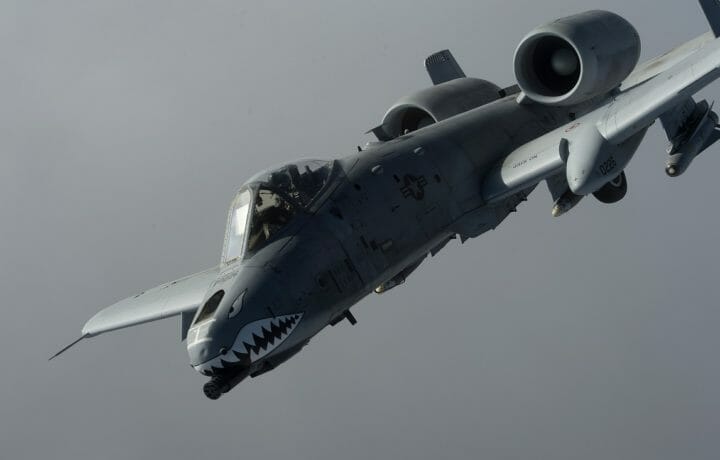The United States Air Force’s Fairchild Republic A-10 Thunderbolt II – more commonly known by its nickname, the Warthog – is an aircraft that is largely considered past its prime, at least against near-peer adversaries. That is why the service has sought to retire the Cold War close-air support (CAS) aircraft from its inventory in the coming decades.
Yet, additional Warthogs are being sent to the Middle East to bolster the U.S. forces in the region, as part of Washington’s build-up to deter Iran and its regional proxies, including the Yemen-based Houthi militants. The A-10s have also proven to be quite effective against Islamic State forces in Syria, as that group has sought to regain ground in the chaos following the fall of the Russian-backed regime of Bashar al-Assad.
From Idaho to Middle East
According to a report from the Idaho State Journal, around 300 airmen and an undisclosed number of A-10 Thunderbolt IIs from Idaho Air National Guard’s 124th Fighter Wing, based at Gowen Field Air National Guard Base, Boise, Idaho, have been deployed to bases in the Middle East. The exact location hasn’t been disclosed due to operational security. The deployment of the 190th Fighter Squadron, which includes pilots, maintenance personnel, and support airmen, will last approximately 180 days, meaning the unit can expect to spend the remainder of the spring and early summer at bases in Syria, Iraq, and elsewhere in the region.
“This deployment exemplifies the extraordinary commitment of the 124th Fighter Wing and its dedicated members, alongside the unwavering support of their families, state and local leaders, neighbors and employers,” Idaho Governor Brad Little told the State Journal. “Idaho’s National Guardsmen continue to inspire patriotism and gratitude through their service and this mission adds a new chapter to the proud tradition of safeguarding our nation.”
This won’t be the 124th FS’s first overseas deployment to the region. It was previously sent to support Operation Freedom’s Sentinel and in 2016 in support of Operation Inherent Resolve, as well as past support for Operations Enduring Freedom (2008), Iraqi Freedom (2007, 2003), and Southern Watch (2003).
“Discipline, preparedness and perseverance underpin the lethality these warriors bring to the war fight,” added Maj. Gen. Tim Donnellan, adjutant general of Idaho and commander of the Idaho National Guard. “Readiness and relevance are our strengths, whether performing our state mission here at home or our federal mission abroad. The 124th has a legacy of service to our state and nation and this mission further cements our commitment to protecting the United States of America and securing our interests around the globe.”
B-2 Spirits Headed to Middle Eastern Skies
Last week, the United States Air Force also deployed at least four Northrop B-2 Spirit strategic bombers from Whiteman Air Force Base (AFB), Missouri, to the Indian Ocean island of Diego Garcia. From that location, the aircraft could strike positions in the Middle East in a few hours – rather than the dozen plus hours it takes to fly from Whiteman.
Last October, two Spirits flew a CONUS-to-CONUS mission from Whiteman to bomb five hardened underground Houthi sites. By operating from Diego Garcia, the bombers could carry out multiple sorties in the time it would take just to fly to the U.S. and back.
As Forbes.com recently reported, “The stealth bomber can carry the enormous 30,000-pound GBU-57 Massive Ordnance Penetrator, one of the few capable non-nuclear bunker buster bombs capable of destroying Iran’s reinforced, underground nuclear sites.”
The U.S. Air Force currently operates just nineteen B-2s, meaning that the deployment of four of the flying wing aircraft represents more than a fifth of the whole fleet.
Second Carrier Also Steaming to the Region
In addition to the aircraft build-up, it was announced last week that Secretary of Defense Pete Hegseth has ordered the U.S. Navy’s Nimitz-class nuclear-powered supercarrier USS Carl Vinson (CVN-70) to head to the Middle East to join the USS Harry S. Truman (CVN-75), which arrived in the region in late November of last year.
The U.S. Navy has maintained a near-constant rotation of aircraft carriers in the region to counter Houthi aggression, which has included the targeting of commercial vessels in the Red Sea and Gulf of Aden. The Iran-backed militant group has also made repeated claims of strikes against U.S. warships, and on social media has claimed to have even damaged the vessels.
The Pentagon has denied that any U.S. Navy vessels have taken any hits.
It is unclear how long the U.S. will maintain two Nimitz-class carriers in the region, but it is likely CVN-75 will return back to the United States as the carrier and strike group departed from Naval Station Norfolk, Virginia, last September.




